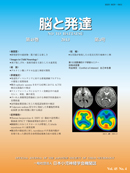All issues

Volume 43, Issue 3
Displaying 1-18 of 18 articles from this issue
- |<
- <
- 1
- >
- >|
-
[in Japanese]2011Volume 43Issue 3 Pages 170
Published: 2011
Released on J-STAGE: December 25, 2014
JOURNAL FREE ACCESSDownload PDF (158K)
-
[in Japanese], [in Japanese], [in Japanese], [in Japanese], [in Japane ...2011Volume 43Issue 3 Pages 173-182
Published: 2011
Released on J-STAGE: December 25, 2014
JOURNAL FREE ACCESSDownload PDF (856K)
-
Takaomi Taira2011Volume 43Issue 3 Pages 183-188
Published: 2011
Released on J-STAGE: December 25, 2014
JOURNAL FREE ACCESSThe neurosurgical treatment of dystonia has progressed markedly since the introduction of deep brain stimulation of the globus pallidum interna. However, dystonia is not a single disorder but comprises various types and causes, and it is true that deep brain stimulation cannot cover the complex nature of dystonia. Depending on the distribution of symptoms and causes, we have to consider other surgical managements such as thalamotomy, peripheral denervation, and intrathecal baclofen. Such a multi-modal strategy has enabled us to treat and even cure many patients with dystonias. No treatment other than various neurosurgical approaches yields better results in the management of dystonias. In this sense, we are now at a stage where we should regard dystonia as a neurosurgical disorder in terms of treatment.View full abstractDownload PDF (1462K)
-
[in Japanese], [in Japanese]2011Volume 43Issue 3 Pages 189-190
Published: 2011
Released on J-STAGE: December 25, 2014
JOURNAL FREE ACCESSDownload PDF (293K) -
[in Japanese]2011Volume 43Issue 3 Pages 191-194
Published: 2011
Released on J-STAGE: December 25, 2014
JOURNAL FREE ACCESS -
[in Japanese], [in Japanese]2011Volume 43Issue 3 Pages 195-199
Published: 2011
Released on J-STAGE: December 25, 2014
JOURNAL FREE ACCESS -
[in Japanese], [in Japanese], [in Japanese], [in Japanese], Klas Blomg ...2011Volume 43Issue 3 Pages 201-205
Published: 2011
Released on J-STAGE: December 25, 2014
JOURNAL FREE ACCESS -
[in Japanese]2011Volume 43Issue 3 Pages 206-210
Published: 2011
Released on J-STAGE: December 25, 2014
JOURNAL FREE ACCESS -
[in Japanese]2011Volume 43Issue 3 Pages 212-216
Published: 2011
Released on J-STAGE: December 25, 2014
JOURNAL FREE ACCESS
-
[in Japanese], [in Japanese]2011Volume 43Issue 3 Pages 217-219
Published: 2011
Released on J-STAGE: December 25, 2014
JOURNAL FREE ACCESSDownload PDF (292K)
-
[in Japanese]2011Volume 43Issue 3 Pages 220-222
Published: 2011
Released on J-STAGE: December 25, 2014
JOURNAL FREE ACCESSDownload PDF (296K)
-
Toshihide Watanabe, Reiki Oyanagi, Kimio Minagawa2011Volume 43Issue 3 Pages 223-227
Published: 2011
Released on J-STAGE: December 25, 2014
JOURNAL FREE ACCESSTopiramate (TPM) was administered to 25 children with intractable generalized epilepsy. A ≥50% decrease in seizure frequency was observed in 56% and 45% of children at two months and one year after initiation of TPM therapy, respectively. However, efficacy of TPM for Lennox-Gastaut syndrome was low. TPM therapy was discontinued in five of 25 children at 3-5.5 months due to lack of efficacy or aggravation of seizures. No serious adverse effects were observed during TPM therapy. The present study revealed that TPM has clinical efficacy in the treatment of children with intractable generalized epilepsy.View full abstractDownload PDF (231K)
-
Tomoki Takechi, Daisuke Usui, Masumi Fukui, Hideo Ogura2011Volume 43Issue 3 Pages 228-232
Published: 2011
Released on J-STAGE: December 25, 2014
JOURNAL FREE ACCESSIn patients with severe motor and intellectual disabilities (SMID), fatal esophageal hemorrhage including penetration of the descending aorta, has often been reported. We experienced 2 patients with severe scoliosis who developed esophageal hemorrhage during catheter placement in the esophagus. We compared chest CT images of these cases with those of 38 SMID patients in our hospital. As a result, a few patients showed esophagus bending to the left of the descending aorta while the vertebral body curved to the right and the mediastinum shifted to the left. It is suggested that there is a risk of esophageal hemorrhage caused by catheter stimulation, when a catheter is placed in the esophagus in such patients. It is therefore necessary to use the thinnest and softest catheter possible and to consider the indications for gastrostomy.View full abstractDownload PDF (575K) -
Takeshi Inoue, Yuriko Tanaka, Ryoko Otani, Hisashi Itabashi, Nobuyuki ...2011Volume 43Issue 3 Pages 233-237
Published: 2011
Released on J-STAGE: December 25, 2014
JOURNAL FREE ACCESSValproate sodium (VPA) is a commonly used antiepileptic drug. However, various side effects, including liver dysfunction, thrombocytopenia, anorexia, hyperammonemia, and pancreatitis have been reported in association with the administration of VPA. Recently, renal Fanconi syndrome associated with VPA treatment has occasionally been reported. However, the mechanisms and detailed characteristics of this adverse effect remain unknown.
We herein report three cases of Fanconi syndrome associated with VPA treatment. All of these patients were severely disabled children, who had been previously treated with multiple antiepileptic drugs, and also required tube feeding. The possible risk factors of Fanconi syndrome in these three cases were similar to those previously reported in the literature. In addition, all three patients developed Fanconi syndrome after the onset of bacterial infections. Before developing Fanconi syndrome, hypouricemia was observed in all three and an increased urinary level of β2 microglobulin (β2MG) was also noted in one of the patients. None of these patients had hypophosphatemia. Two patients had an appropriate serum VPA level, while the other had an inappropriately high level.
We therefore recommend that severely disabled children receiving multiple antiepileptic drugs and tube feeding be periodically checked for urinary β2MG and uric acid, especially during the course of any infectious episodes.View full abstractDownload PDF (287K)
-
[in Japanese]2011Volume 43Issue 3 Pages 239-240
Published: 2011
Released on J-STAGE: December 25, 2014
JOURNAL FREE ACCESS
-
[in Japanese]2011Volume 43Issue 3 Pages 241-243
Published: 2011
Released on J-STAGE: December 25, 2014
JOURNAL FREE ACCESSDownload PDF (211K)
-
2011Volume 43Issue 3 Pages 250-253
Published: 2011
Released on J-STAGE: December 25, 2014
JOURNAL FREE ACCESSDownload PDF (449K) -
2011Volume 43Issue 3 Pages 253-254
Published: 2011
Released on J-STAGE: December 25, 2014
JOURNAL FREE ACCESSDownload PDF (425K)
- |<
- <
- 1
- >
- >|